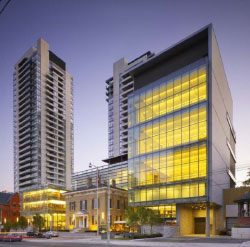
Case studies offer two distinct opportunities for learning: First, analyzing individual case studies provides specific examples and results. Second, comparing multiple case studies offers an insight into the commonalities and differences among projects. Learning from case studies in both ways provides a greater understanding of the key elements necessary to successfully create a design+technology jobs cluster in downtown San Diego, and helps shape our approach to the I.D.E.A. district.
Common Traits Among Leading Cities
Quality of Place
In addition to technology and talent, creative centers typically have desirable local characteristics – attractive natural and built environments, a diverse mix of residents, and a vibrant, urban life. In particular, cities with higher levels of diversity tend to attract more creative people.
Cultivation of Human Capital
Innovative cities are frequently places that have a high concentration of well-educated individuals with the ability to gain and retain skills. In almost all cases studied, and in keeping with Cortright’s mandate, the intentional decision to attract and cultivate human capital served as a catalyst for cluster formation and growth.
Government Involvement/Public Policies
Although cluster development may occur independent of significant government intervention, public policy often plays a key role in catalyzing initial growth, and then maintaining and augmenting cluster growth over time. At a broad level, government involvement facilitates projects by providing project funding, or by creating the necessary infrastructure for growth. At a local scale, governments are able to provide entrepreneurs with services ranging from reduced tax obligations, securing of loans, networking, and business development.
Anchor Firms/Institutions
For almost all clusters, the role of anchor institutions such as universities, medical centers, performing arts complexes, significant corporate headquarters or public institutions as collaborating or mediating organizations proves to be important. Some organizations help catalyze innovative activities, while others actually emerge as part of the process. These anchor firms facilitate the exchange of information and foster joint actions that improve the overall business and creative environment.
Synergy between Government, Academic, and Private Institutions
Most creative communities grow near universities, where learning and collaborative activity are woven into the local culture. Universities can become incubators for startup firms. They provide places where knowledge is created, where specialized research is cultivated, and where scientists and industry work together on product development.
Availability of Venture Capital
A source of continuing investment in product development is essential to the growth of creative clusters—especially in design and R&D. To develop products in a creative process often takes a significant amount of time and money. During the time necessary for initial development, firms will depend on venture capital to underwrite initial costs.
“San Diego’s success is a story of how academia, local business and political interests have come together…”1
WEIPING WU,
Associate Professor,
Virginia Commonwealth University
San Diego
Biomedical/Research & Development
Relevance
San Diego is an archetypal example of economic clusters establishing, sustaining, and growing the local economy into a broad-based, diverse national hub of innovation businesses.
Before
San Diego has always offered an attractive physical environment. The weather is near perfect and the region has numerous recreational amenities. Through the 1950s, San Diego’s economy was dominated by the military, defense contractors, real estate, and tourism. Some research institutions (later to become crucial components of San Diego’s cluster emergence) including The Scripps Institute of Oceanography, The Scripps Research Institute, and General Atomics, also existed.
Catalysts
In the early 1960s, San Diego business leaders recruited two research and teaching institutions—The Salk Institute for Biological Studies, and The University of California—to locate just north of La Jolla on a defunct Marine base. To accommodate growth, the city of San Diego zoned the land favorably for R&D uses.2
Key Elements:
- Quality of Place: San Diego’s attractive natural environment and the region’s entrepreneurial business climate have proven to be important factors in attracting human capital.
- Interdisciplinary Approach: Open communication between private companies, university and research centers, and academia results in a productive, synergistic environment. Each discipline informs the next in a virtuous cycle of creativity, development, and invention within the cluster.
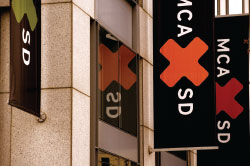
Success of Anchor Firm/Tenant: Hybritech played a leadership role by demonstrating the viability of biotech R&D industries in San Diego. In addition, the company’s success at the application of biotech uses spread to other firms and to the community as a whole.3 Spinoffs by former Hybritech employees also gave rise to a core of local venture capitalists looking to capitalize on biotech startups.4
Development of Social Networks: CONNECT was formed in 1985 to “link inventors and entrepreneurs with the resources they need for commercialization of products.”5 It has since assisted in the formation and development of more than 2,000 companies and has been mirrored in almost 40 regions around the world.6
Development of Human Capital: Research and educational institutions provide the cluster with a well-trained, creative workforce which is educated by both professional and pedagogical inputs. They also provide cutting-edge, innovative information to sustain the cluster’s competitive advantage. Additionally, these institutions facilitate interaction with government/ regulatory bodies to ensure that infrastructure and public policy issues are addressed favorably.
Impact
- The development of Biomed R&D clusters has reduced San Diego’s reliance on tourism and military/defense spending.
- San Diego has nearly 6,000 technology companies today, employing nearly 140,000 people.7
- Technology companies represent 6% of the region’s employers and pay on average 90% more than the median salary. This is approximately 21% of region’s wages.8
- Patents per worker have grown to more than 22x the national average.9
- Venture capital funding is more than 32x the national average.10
- In 40 years, UCSD has emerged as the 5th university in the nation for R&D funding.11

San Francisco Bay Area
New/Digital Media
Relevance
The Bay Area is a powerful example of the synergy that occurs when multiple economic clusters interact. In particular, it shows how industries are enhanced through competition and cooperation; and currently, it is demonstrating the strong appeal of urban spaces to tech companies and workers.
Before
Silicon Valley has been a Bay Area staple for electronics development since the early 1900s. Beginning in the 1950s, an agglomeration economy surrounding the electronics industry and local educational/research institutions including Stanford and Cal was formed. Industries served as leaders in establishing the technological, financial, corporate, and human resources infrastructure necessary to form a dynamic cluster in the Bay Area.12
Catalysts
Three key factors influenced the rise of the ‘Multimedia Gulch’ in San Francisco’s South of Market (SOMA) district.
- An emerging trend for home video games and computer-generated graphics in the 1970s and 80s.13
- Conversions in the SOMA district turned defunct light industrial factories into affordable live-work lofts for artists.
- Start-up companies—Macromedia and Adobe—chose to open shops due to attractive living options and availability of space.
In less than ten years, a full community of game developers, designers, actors, and musicians developed—a creative economy that thrived due to its urban location. Today, this ecosystem has evolved to include next-generation Internet titans like Square and Twitter who have intentionally chosen the urban environment over the Valley because it is the preferred location of their young workforce. At the other end of the size spectrum, SOMA is a hotbed of entrepreneurial activity. On recent report stated that there are over 5000 start-ups in SOMA alone.
Key Elements
- Quality of Life: The same lifestyle that attracted the Silicon Valley industry cluster attracts those in the tech and new media clusters. The San Francisco Bay Area consistently ranks at the top of national quality of life, health, recreation, transportation and culture indexes.
- Industry Leading Companies: The Bay Area new/digital media cluster is home to front- runners in the industry. Core companies—like Macromedia and Adobe—provide credibility to other industries within the cluster. Additionally, these companies further the ‘cluster effect’ by allowing a large community of early-adopting users to use industry leading products, before counterparts in other regions— thereby establishing competitive industry advantage within the area.
Cross Fertilization: New technology is a ‘fusion technology’ that involves the integration of several different industries. The existence of technology companies, content providers, and specialized communication infrastructure, allows for the growth of each independently and in combination.14
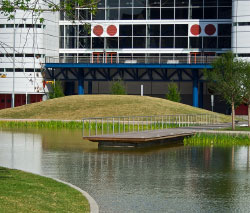
Entrepreneurial/Creative Approach: An entrepreneurial ethic within the Bay Area allows for the conceptualization and establishment of new businesses and industries where they do not exist today. Additionally, the existence of creative talent within the Bay Area, and the absence of a traditional media cluster to employ this talent, has created an opportunity for emerging talent to work within the new media industry, thereby furthering product development and creating “compelling new experiences.”15 16
Government Economic Approach: Since the late 1990s, Bay Area policy makers have been increasingly focused on expanding agglomeration economies beyond Silicon Valley to the broader Bay Area region as a whole. This approach allows knowledge to spread regionally, but also stay within area, as opposed to jumping overseas, which limits the benefit of the cluster effect. San Francisco Mayor Ed Lee has been aggressively courting tech firms with tax incentives, sometimes to the consternation of local residents.17
Establishment of Support Services: The Bay Area enjoys a well- established system of support services. These allow entrepreneurs to conceive, develop, and successfully operate their enterprises. The support services include network/ training organizations, incubators, financial assistance sources and private investors.18
Availability of Venture Capital: The San Francisco Bay area offers a wealth of venture capital opportunities for entrepreneurs. Industries in the area receive nearly one-third of all US venture capital annually.19
Impact
- An estimated 67,000 people representing more than 2,000 firms are engaged in multimedia.20
- More than 50 digital entertainment companies operate in the Bay Area.21
- The concentration of multimedia activity is two and half times the national average.22
- Multimedia-related jobs pay 65% more than the average Bay Area salary.23
- Cross-fertilization of multiple industry clusters cultivates a highly efficient, productive economy economic environment.24
- Highest economic productivity in the nation—almost twice the national average.
- Highest density of venture capital firms in the world.
- More Fortune 500 companies than any region except New York City.
- Most highly educated workforce in the nation, with highest percentage of residents with graduate and professional degrees.
- Largest number of top-10 ranked graduate programs in business, law, medicine, and engineering.
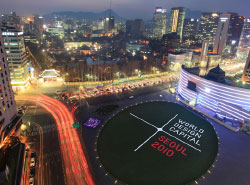
Seoul, Korea
Creative/Knowledge-Based Industries
Relevance
Seoul demonstrates how investment in creativity and knowledge-based service industries can stimulate urban economic growth. In particular, Seoul shows the value that design offers to a broader, national economy.
Before
In the post-war 1960s, Korea’s government focused on an export-oriented industrialization policy. Although impressive growth occurred, the economy became increasingly tied to the global market, which led to uncertainties of Seoul’s export economy being undercut by manufacturing competitors in other countries.25
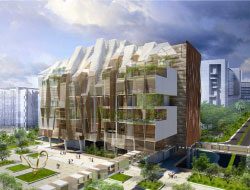
Catalysts
To offset its slipping foothold in the export economy, South Korea shifted its focus away from manufacturing towards high-tech production.
Seoul city government played a major role in helping the city to enact this transition. They pursued an industrial policy known as the Creative Industry Promotion Program and focused on knowledge-based industries as the engine for growth. Six industries were specified: tourism, design and fashion, digital content, conventions, research and development in technology, and financial and business services.
The Seoul Design Foundation was created in 2008 to specifically promote the design industry. The Design Foundation is charged with multiple responsibilities: supporting start-up design entrepreneurs, operation of Dongdaemun Design Plaza, organizing design events, design development promotion, supporting small design firms, and supporting design promotion through marketing.
Promote Design Clusters: Specific cluster areas were established within the city and specifically aligned with existing infrastructure/facilities such as businesses in place, universities, and research institutions.
Consolidate Design Infrastructure: Design support centers and design studios served to consolidate and support the industry by facilitating the growth of a design culture. Design support centers “integrated, invigorated and promoted the market design industries, and now function as a community for design companies to exchange information and build networks to create more business opportunities and boost economic growth.”26
Marketing Support: Government agencies, such as the Seoul Design Foundation, provide support to emerging design industries. These agencies focus on three primary functions:
- Assist design companies in turning design ideas into products which then enhances market value and global competitiveness of Korean products,
- Sponsor International exhibitions; and
- Provide awards for outstanding design products and supporting them through marketing/promotion.27
Design Training: Aspiring designers are provided support through marketing and consulting activities.
Collaboration between Government and Leading Conglomerates: Through government involvement and guidance, research and development efforts are accelerated, products are brought to market more quickly, and innovative approaches are established. For example: Three major Korean semiconductor producers were making redundant investments. The government stepped in with a specific goal of producing a next generation memory chip. By pooling their resources, the government and private industries laid the groundwork for a chip that became the world market leader just a few years later.28
Impact:
- Seoul recognized by International Council of Societies of Industrial Design (ICSID) as the World Design Capital in 2010.29
- Samsung grew from virtually no global market share in memory chips in 1984 to just over 10% less than 10 years.30
- Seoul’s global brand value ranking expected to enter the top 20 (from 33rd) within next five years.31
- Design industry expected to generate over 25,000 new jobs over the next five years.32
- Design industry and market expected to expand from six trillion KRW to 10 trillion KRW within 10 years.33
- As of 2003, the capital region accounted for 55% of all manufacturing firms, 73% of total R&D institutions, and 77% of Korea’s venture companies, and 88% of all headquarters of major large enterprises.34
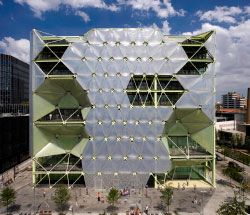
22@Barcelona
Multi-industry innovation district
Relevance
Barcelona, Spain shares many physical and cultural traits with San Diego. The 22@Barcelona District is an example of how concentrating knowledge-based activities can transform an underutilized area into a high-quality living, working, and learning environment.
Before
22@Barcelona is located within Barcelona’s Poblenou neighborhood, a sub area of the San Martin District that spans the entire southeastern quadrant of Barcelona. Poblenou was historically an industrial neighborhood. For over 100 years, it served as the primary economic driver for the city of Barcelona and province of Catalonia. As a result of significant de-industrialization between the 1960s and 1990s; Poblenou lost more than 1,300 industrial users. Individual buildings, and the neighborhood as a whole, were degraded and abandoned. This was exacerbated by the fact that railways and other transit systems, once used for transportation of industrial goods, separated the neighborhood from the rest of the city.
Catalysts
1992: The Summer Olympic Games were the primary catalyst for revitalizing the Poblenou neighborhood, which would later include the 22@Barcelona district. Funding allocated to infrastructure allowed for new roads and connections that linked the once-isolated district to the port, airport, and beaches. Additionally, a direct connection was established between Poblenou and the business core of the city.
2000: Barcelona’s civic leaders amended the Metropolitan Master Plan to include refurbishment of industrial lands within Poblenou. This provided the implementation strategy and approach necessary for successful revitalization. Today this is known as the 22@ Plan.
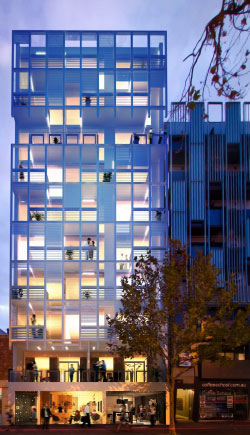
Key Elements
Connection to Downtown/Business Core: Roads and transit connections allow residents/users of the once-isolated district to travel between the established city cores the new district with ease.
Focus on Key Sectors: Innovative, complementary, and future-based sectors are targeted such as media, ITC, MeTech, energy, and design.
Visionary Land Use Approach: Incentives are focused on maintaining jobs within the district – replacing industrial activity with offices or other businesses services. In this way, land owners are encouraged to update obsolete historic urban planning elements while maintaining economic activity within the neighborhood. Without this approach—simply rezoning from industrial to residential—maintaining jobs in the neighborhood would not have occurred.
Creation of Cluster Infrastructure: Several projects focused on attracting universities and educational centers, creating spaces for small and medium-sized businesses, creating business incubators, building residences for professionals, providing access to services such as venture capital and networking.
Development of Social Networks: 22@Network was formed to facilitate the integration of companies and institutions within the district. They serve to enhance communication between companies and employees and thereby enhance the social fabric of the district and city as a whole.
Dedicated Efforts to Promote District: 22@Barcelona Company is an agent for economic development within the district by facilitating innovation. It assists businesses by attracting and retaining talent, as well as marketing the district’s business, science, and teaching activities to a national and international market.
Impact:35
- Over 67% of vertical improvements within the district have commenced, implemented through 110 improvement plans.
- 74 of the 110 plans, (582,880 square meters) are organized by the private sector.
- Over 2,824,709 square meters of land obtained for new production facilities, social housing, and technical services.
- 1,502 new firms established
- More than 44,600 new workers in the district.
Endnotes
- Wu, Pg. 19 ↩
- Wolshok, Furtek, Lee, Winham. Pg. 32–33 ↩
- Wu, Pg. 20 ↩
- Wu, Pg. 20 ↩
- http://www.connect.org/about/ ↩
- http://www.connect.org/about/ ↩
- http://www.connect.org/about/ ↩
- http://www.connect.org/about/ ↩
- Wu, Pg. 19 ↩
- Wolshok, Furtek, Lee, Winham. Pg ↩
- Wolshok, Furtek, Lee, Winham. Pg 32–33 ↩
- New Media Cluster Strategy, ICF consulting pg 2 ↩
- Results of the Economic Base and Industry Cluster Studies, Technology Trade and Commerce Agency, pg. 69 ↩
- Results of the Economic Base and Industry Cluster Studies, Technology Trade and Commerce Agency, pg. 69 ↩
- Results of the Economic Base and Industry Cluster Studies, Technology Trade and Commerce Agency, pg. 69 ↩
- New Media Cluster Strategy, ICF consulting pg 2 ↩
- The Evolution of Knowledge Clusters, Huggins, pg279 ↩
- San Francisco Bay Area Resources for Entrepreneurs, pg 1. ↩
- New Media Cluster Strategy, ICF consulting pg3 ↩
- Results of the Economic Base and Industry Cluster Studies, Technology Trade and Commerce Agency, pg. 62 ↩
- http://www.villageprofile.com/california/sanfrancisco/08/topic.htm ↩
- Results of the Economic Base and Industry Cluster Studies, Technology Trade and Commerce Agency, pg. 62 ↩
- Results of the Economic Base and Industry Cluster Studies, Technology Trade and Commerce Agency, pg. 62 ↩
- http://www.villageprofile.com/california/sanfrancisco/08/topic.html ↩
- http://www.urban-age.net/conferences/chicago/gmm/case-studies/ ↩
- http://www.seouldesign.or.kr/eng/design/summary.jsp ↩
- http://www.seouldesign.or.kr/eng/design/summary.jsp ↩
- http://www.urban-age.net/conferences/chicago/gmm/case-studies/ ↩
- http://www.koreabrand.net/en/know/know_view.do?CATE_CD=0008&SEQ=1729 ↩
- http://www.urban-age.net/conferences/chicago/gmm/case-studies/ ↩
- http://www.koreabrand.net/en/know/know_view.do?CATE_CD=0008&SEQ=1729 ↩
- http://www.koreabrand.net/en/know/know_view.do?CATE_CD=0008&SEQ=1729 ↩
- http://www.koreabrand.net/en/know/know_view.do?CATE_CD=0008&SEQ=1729 ↩
- http://www.koreabrand.net/en/know/know_view.do?CATE_CD=0008&SEQ=1729 ↩
- http://www.22barcelona.com ↩